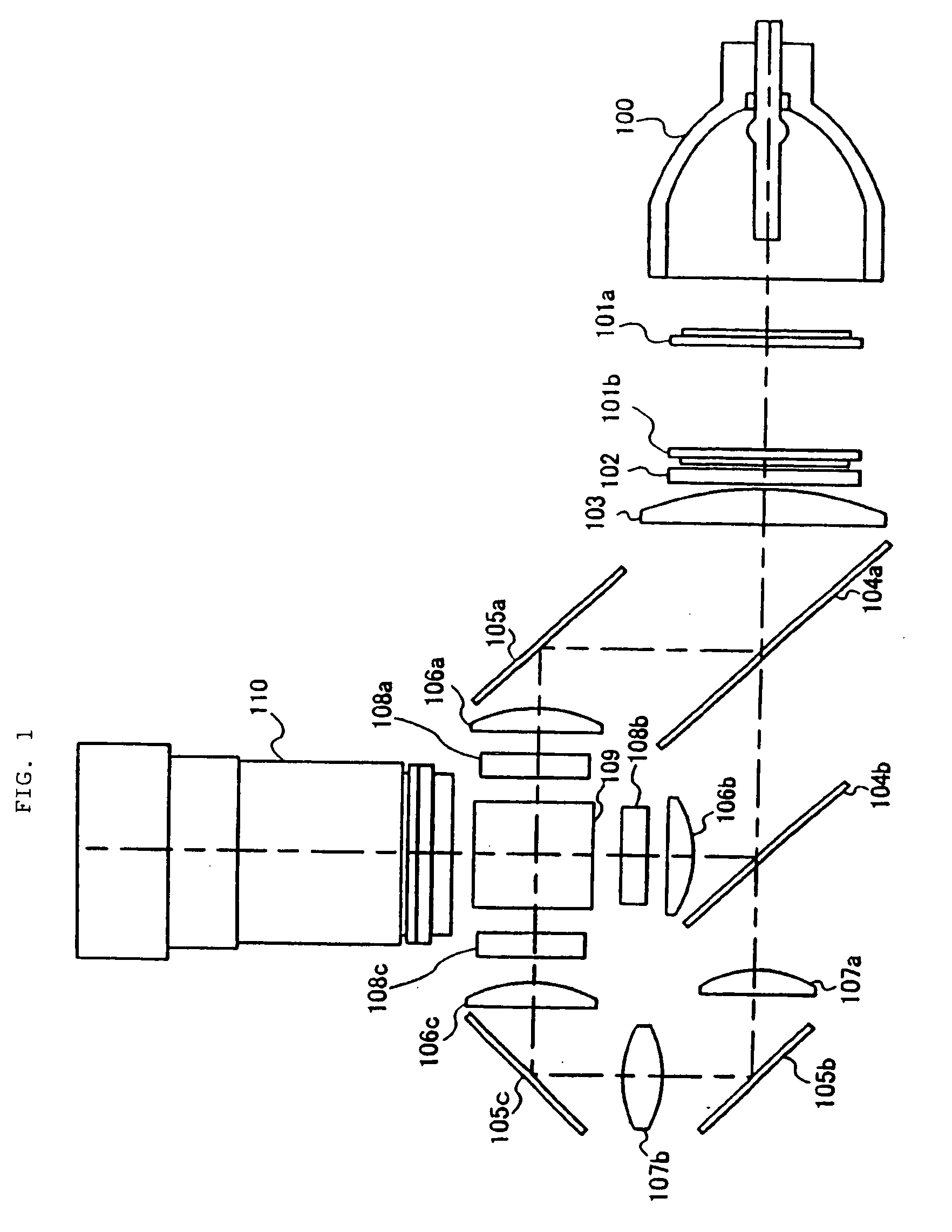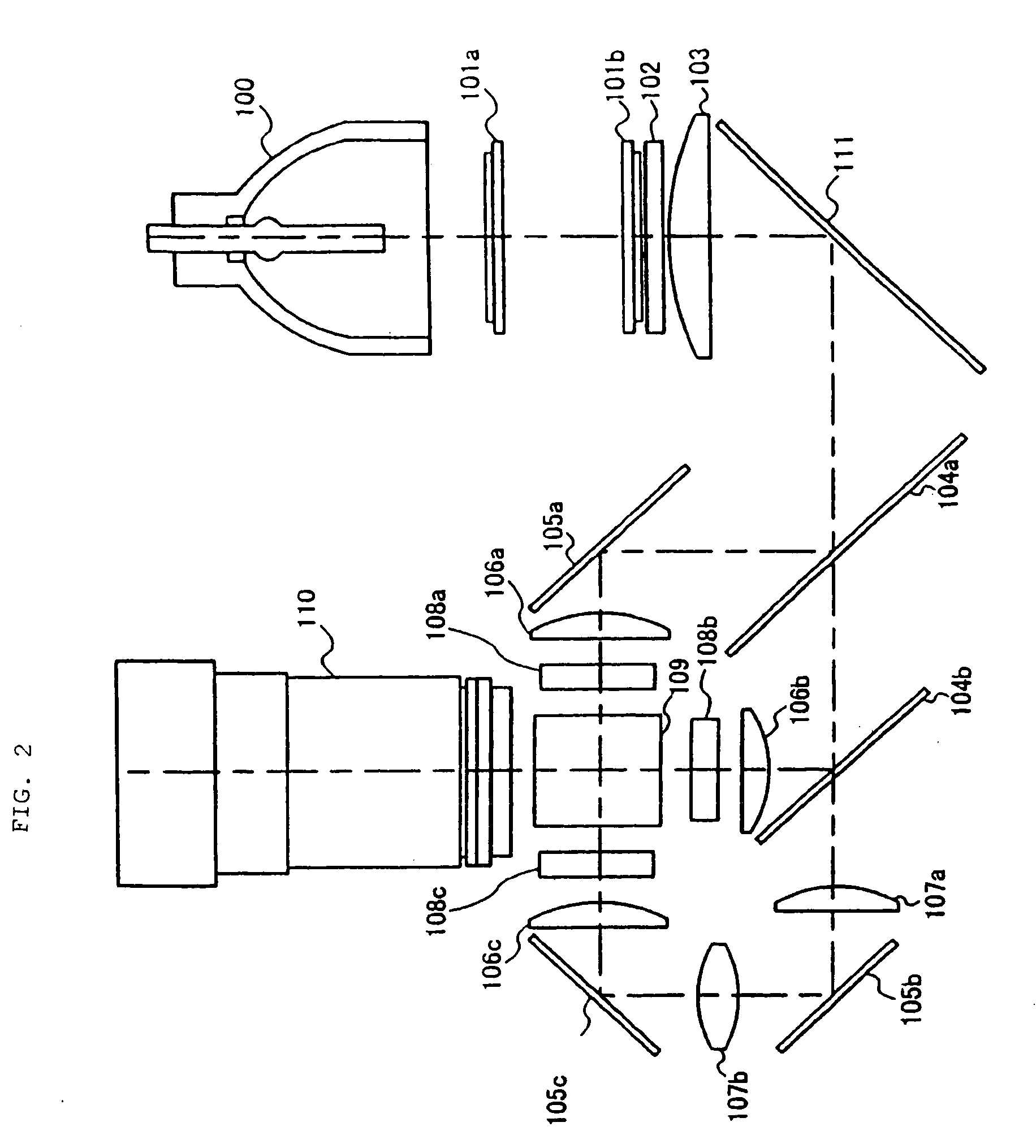Illuminating optical system for projector
a technology of projectors and optical systems, applied in the field of projector illumination optical systems, can solve the problems of reducing polarization conversion efficiency, and adding new lenses, and achieve the effect of high illumination efficiency
- Summary
- Abstract
- Description
- Claims
- Application Information
AI Technical Summary
Benefits of technology
Problems solved by technology
Method used
Image
Examples
first exemplary embodiment
[0088]FIG. 4 shows the configuration of an illuminating optical system for a liquid crystal projector according to a first exemplary embodiment. As shown in FIG. 4, the illuminating optical system according to the exemplary embodiment corresponds to the optical system shown in FIG. 2 and from which condenser lenses 106a and 106b are omitted, with condenser lens 106 located between dichroic mirror 104a and fold-back mirror 111. The optical system is configured to superimposedly irradiate liquid crystal panels 108a and 108b, through field lens 103, with a luminous flux from light source 100 divided by integrator 101a. The arc images of light source 100 are formed on integrator 101b and in the vicinity of integrator 101b by integrator 101a.
[0089]Condenser lens 106 is configured to substantially parallelize principal rays of a luminous flux having passed through field lens 103, located between polarization converting element 102 and fold-back mirror 111. The distance between field lens...
second exemplary embodiment
[0094]FIG. 8 shows the configuration of an illuminating optical system for a liquid crystal projector according to a second exemplary embodiment. As shown in FIG. 8, the illuminating optical system according to the exemplary embodiment corresponds to the optical system shown in FIG. 2 and from which condenser lenses 106a and 106b are omitted, with condenser lens 116a located between dichroic mirror 104a and mirror 105a and condenser lens 116b located between dichroic mirrors 104a and 104b. The optical system is configured to superimposedly irradiate liquid crystal panels 108a and 108b with a luminous flux from light source 100 divided by integrator 101a, the luminous flux having passed through field lens 103 and condenser lenses 116a and 116b.
[0095]Each of condenser lenses 116a and 116b is configured to substantially parallelize principal rays of a luminous flux having passed through field lens 103 located between polarization converting element 102 and fold-back mirror 111. The di...
example
[0098]FIG. 9 shows design data on the optical elements of the illuminating optical system shown in FIG. 8. The design data has been calculated using existing optical simulation software. In FIG. 9, “IT1” and “IT2” correspond to integrators 101a and 101b, respectively. “PBS” and “FL” correspond to polarization converting element 102 and field lens 103, respectively. “CL” and “LCD” correspond to condenser lens 116a (or 116b) and liquid crystal panel 108a (or 108b), respectively. A “Radius” column shows the radii of curvature of surfaces of the arranged optical elements (IT1, IT2, PBS, FL, CL, and LCD) in millimeters. “∞” in the “Radius” column denotes a plane. A “Thickness” column shows the thickness of each of the optical elements or the distance between the optical elements in millimeters. An “Index” column shows the refractive index of each of the optical elements. The distance between the optical elements is shown as a linear distance equivalent.
[0099]In the illuminating optical s...
PUM
 Login to View More
Login to View More Abstract
Description
Claims
Application Information
 Login to View More
Login to View More - R&D
- Intellectual Property
- Life Sciences
- Materials
- Tech Scout
- Unparalleled Data Quality
- Higher Quality Content
- 60% Fewer Hallucinations
Browse by: Latest US Patents, China's latest patents, Technical Efficacy Thesaurus, Application Domain, Technology Topic, Popular Technical Reports.
© 2025 PatSnap. All rights reserved.Legal|Privacy policy|Modern Slavery Act Transparency Statement|Sitemap|About US| Contact US: help@patsnap.com



